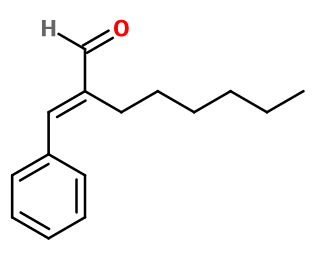Jasmonal H®
Synthétique
Floral > Light Flowers > White Flowers > Anisic > Green Fruits

Crédits photo: ScenTree SAS
Other names :
Hexyl Cinnamaldehyde ; Hexyl Cinnamaldehyde ; 2-(phenylmethylidene)octanal ; 2-benzylidene octanal ; Hexyl cinnamal ; Hexyl cinnamic aldehyde ; 2-hexyl-3-phenyl-2-propenal ; Alpha-N-hexyl-beta-phenyl acrolein ; 2-(phenylmethylidene)octanal
Volatility :
Heart
Uses in perfumery :
Jasmonal H® is used in notes of jasmine and lily of the valley, for a waxy facet, close to narcissus, and for trail. Formerly used to replace Hedione®.
Natural availability :
Jasmonal H® is found in trace amounts in Roman Chamomile EO and rice. However, it is the synthetic Jasmonal H® that is most often used in perfumery.
Year of discovery :
1930
Other comments :
Jasmonal A® is more powerful, rising and soapy, but less watery than Jasmonal H®.
Jasmonal H® is one of the 26 allergens in perfumery.
Jasmonal H® is one of the 26 allergens in perfumery.
Price Range :
€
Stability :
Aldehydes may form diethylacetals in alcoholic perfumes, with no real impact on their smell.
Jamsonal A colors through time.
Jamsonal A colors through time.

Crédits photo: ScenTree SAS
- Molecular formula :
- C15H20O
- Molecular Weight :
- 216,32 g/mol
- Density :
- 0,955
- Flash Point :
- 151°C
- Fusion Point :
- 18°C
- Appearance :
- Colorless liquid
- Log P :
- 5,3
- Boiling Point :
- 311°C
- Detection Threshold :
- Donnée indisponible.
Synthesis route :
As for Jasmonal A®, the synthesis of Jasmonal H® is made by condensation of benzaldehyde with Octanal (Aldehyde C-8), using an excess of benzaldehyde and gradually adding the Aldehyde C-8 in the reaction medium in order to avoid its self-condensation.
Synthesis precursor :
Jasmonal H® is not a precursor to the synthesis of another compound of olfactory interest.
Isomerism :
Jasmonal H® has two possible diastereoisomers. However, it is the mixture of the two isomers that is used in perfumery.
- EINECS number :
- 202-983-3
- FEMA number :
- 2569
- JECFA number :
- 686
- FLAVIS number :
- 05.041
- Allergens :
- Jasmonal H® may provoke an allergic reaction on skin contact (redness, heat, scraching, prickling) for some people.
- IFRA :
- This ingredient is restricted by IFRA
- Restriction type :
- RESTRICTION
- Cause of restriction :
- DERMAL SENSITIZATION
- Amendment :
- 49
- Comments :
- This ingredient is part of the Schiff base (α-Hexylcinnamic aldehyde methyl anthranilate (or Jasmea H) - N°CAS : 67924-13-4) and induces the application of IFRA regulations for 61,8% of the Schiff base usage. Please also refer to the IFRA Annex II for more information
- Quantitative limit on the use :
-
Cat.1 Cat.2 Cat.3 Cat.4 Cat.5A Cat.5B Cat.5C Cat.5D Cat.6 1,8 % 0,53 % 11 % 9,9 % 2,5 % 2,5 % 2,5 % 2,5 % 5,8 % Cat.7A Cat.7B Cat.8 Cat.9 Cat.10A Cat.10B Cat.11A Cat.11B Cat.12 20 % 20 % 1 % 19 % 69 % 69 % 38 % 38 % No Restriction - Restriction type :
- RESTRICTION QRA
- Cause of restriction :
- SENSITIZATION
- Amendment :
- 47
- Comments :
- This ingredient is part of the Schiff base (α-Hexylcinnamic aldehyde methyl anthranilate (or Jasmea H) - N°CAS : 67924-13-4) and induces the application of IFRA regulations for 61,8% of the Schiff base usage. Please also refer to the IFRA Annex II for more information
- Quantitative usage limits :
-
Cat.1 Cat.2 Cat.3 Cat.4 Cat.5 Cat.6 Cat.7 Cat.8 Cat.9 Cat.10 Cat.11 0,7 % 0,9 % 3,6 % 10,7 % 5,6 % 17,1 % 1,8 % 2 % 5 % 2,5 % Not Restricted
To learn more about IFRA's standards : https://ifrafragrance.org/safe-use/library
ScenTree is solely responsible for the information provided here.

